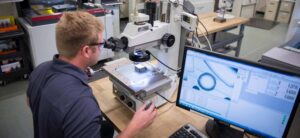
Technical Tip: Managing flash in micromolding
By Shawn Thibeault, Accumold
Plastics ProcessesThe misperception that micromolding is simply a reduction in mold size results in excessive flash in many projects.

Photo Credit: Accumold
Flashing, or flash, is an excess plastic or resin on a molded plastic part. For larger injection molded parts, it’s simply removed. Managing flash in micromolding, however, is both an art and a science. In the movie Will Ferell movie Elf, we know elves are ideal for this task because of their “nimble fingers, natural cheer and active minds.” But because they aren’t for hire (yet), we include flash as part of the final design and manufacturing process.
MANAGING FLASH EXPECTATIONS
Despite its extremely small scale, micromolding is actually similar to other conventional injection molding manufacturing in many ways. To oversimply, there are two moving halves to a tool. Flash, also referred to as burrs, can happen near any non-solid surface, and it happens at the parting line, slide, core pin, ejection location, and/or even the gating location. In the same way removing a tree leaves a stump, the molding process can never fully remove all flash. There are secondary options, but managing flash in micromolding considers its placement in the design itself. Design-for-micromolding (DfMM) engineers consult with OEMs and manufacturers to position a component to limit flash on critical features.
Managing flash expectations is different on every project. Due to the multitude of different sizes, shapes, and materials, DfMM engineers thoroughly consult on every aspect of each project, no matter how minuscule. Many micromolded parts are so incredibly small that critical part features might actually appear as flash to the untrained eye. For this reason, we have to be sticklers for detail. Consider that the smallest micromold production part to date from Accumold is roughly 800µm (0.031 inches) by 300µm (0.012 inches) by 380µm (0.015 inches), with mold walls that can be as thin as 0.003 inches. The only hard rule to managing flash is that it should be expected, explained, and detailed early in the DfMM conversation.
WHY FLASH IS DIFFICULT TO MANAGE
As consumer products, medical devices, and other technologies shrink in size, many traditional injection molders have made the mistake of assuming that micromolding is simply a reduction in mold size. This couldn’t be farther from the truth, and it’s a misperception that results in excessive flash in many micromolding projects. Resin and plastic at micro sizes behave in surprising ways – this is why some plastic/resin manufacturers test their new materials with us; we can often outperform even their own spec sheets.
Molders that aren’t experienced in micromolding (which is most of them) quickly run into difficulty setting up the mold clamping force, tool design, and managing the overall processing parameters. This inexperience can lead to excessive flash and an unusable component. Some molders don’t understand how to manage flash and rely on secondary operations like deburring or degating operations. Unfortunately, this adds significant cost and isn’t always technically possible.
HOW TO PLAN FOR FLASH
Part designers and engineers at the world’s leading tech companies should spend their time making products customers love, or medical devices that save lives. Partnering with pros helps in more ways than just mitigating necessary flash in micro molding, getting expert help also ensures timelines and budgets are managed.
Because molding has an upfront cost, instead of managing flash after the components are produced, it’s more efficient and budget-friendly to review and collaborate on your part design with your micro molder ahead of time. You might even discover your ideal design engineer’s thoughts to be impossible, is achievable. For most micromolders, we call that a Tuesday.
Shawn Thibeault is a senior sales engineer with Accumold, a high-volume precision micromolder headquartered in Ankeny, Iowa. Visit www.accu-mold.com for more.
